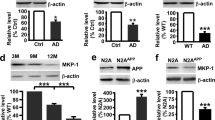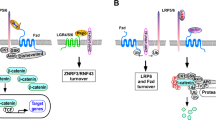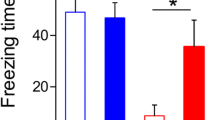Abstract
Alzheimer’s disease (AD) is the most common neurodegenerative disturbances. Dysfunction of synaptic plasticity and decline in cognitive functions are the most prominent features of AD, but the mechanisms of pathogenesis have not been well elucidated. In this paper, transforming growth factor-β1 (TGF-β1) was found to be reduced in the hippocampus of AD mouse which was accompanied by impaired pine density, synaptic plasticity, and memory function. Hippocampal injection of TGF-β1 rescued the AD-induced memory function impairment. In addition, TGF-β1 ameliorated synaptic plasticity and increased synaptic plasticity-associated protein expression including Arc, NR2B, and PSD-95 in mouse model of AD. Furthermore, we demonstrated that Akt/Wnt/β-catenin pathway protein expression in the hippocampus was suppressed in a mouse model of AD and TGF-β1 significantly enhanced the phosphorylation Akt, GSK3β, and increased the nuclear β-catenin. These results indicate that TGF-β1activates PI3K/Akt/Wnt/β-catenin signaling in mouse model of AD, which is important for promoting synaptic plasticity related to memory function. More importantly, suppression of PI3K/Akt/Wnt/β-catenin pathway compromised the beneficial effects of TGFβ1 in Alzheimer’s model. Hence, TGF-β1 shows protective effect on neurons, which might be through the PI3K/Akt/Wnt/β-catenin signaling pathway, serving as a potential target in AD pathology.





Similar content being viewed by others
References
Asadbegi M, Komaki A, Salehi I, Yaghmaei P, Ebrahim-Habibi A, Shahidi S, Sarihi A, Soleimani AS, Golipoor Z (2018) Effects of thymol on amyloid-beta-induced impairments in hippocampal synaptic plasticity in rats fed a high-fat diet. Brain Res Bull 137:338–350
Bae JJ, Xiang YY, Martinez-Canabal A, Frankland PW, Yang BB, Lu WY (2011) Increased transforming growth factor-beta1 modulates glutamate receptor expression in the hippocampus. Int J Physiol Pathophysiol Pharmacol 3:9–20
Caraci F, Bosco P, Signorelli M, Spada RS, Cosentino FI, Toscano G, Bonforte C, Muratore S, Prestianni G, Panerai S, Giambirtone MC, Gulotta E, Romano C, Salluzzo MG, Nicoletti F, Copani A, Drago F, Aguglia E, Ferri R (2012) The CC genotype of transforming growth factor-beta1 increases the risk of late-onset Alzheimer's disease and is associated with AD-related depression. Eur Neuropsychopharmacol 22:281–289
Caraci F, Tascedda F, Merlo S, Benatti C, Spampinato SF, Munafò A, Leggio GM, Nicoletti F, Brunello N, Drago F, Sortino MA, Copani A (2016) Fluoxetine Prevents Abeta1–42-Induced Toxicity via a Paracrine Signaling Mediated by Transforming-Growth-Factor-beta1. Front Pharmacol 7:389
Chacon PJ, Rodriguez-Tebar A (2012) Increased expression of the homologue of enhancer-of-split 1 protects neurons from beta amyloid neurotoxicity and hints at an alternative role for transforming growth factor beta1 as a neuroprotector. Alzheimers Res Ther 4:31
Chang WW, Zhang L, Jin YL, Yao YS (2013) Meta-analysis of the transforming growth factor-beta1 polymorphisms and susceptibility to Alzheimer's disease. J Neural Transm (Vienna) 120:353–360
Chen JH, Ke KF, Lu JH, Qiu YH, Peng YP (2015) Protection of TGF-beta1 against neuroinflammation and neurodegeneration in Abeta1-42-induced Alzheimer's disease model rats. PLoS One 10:e116549
Dezfulian M (2018) A new Alzheimer's disease cell model using B cells to induce beta amyloid plaqueformation and increase TNF alpha expression. Int Immunopharmacol 59:106–112
Dufouil C, Glymour MM (2018) Prediction to prevention in Alzheimer's disease and dementia. Lancet Neurol 17:388–389
Fisichella V, Giurdanella G, Platania CB, Romano GL, Leggio GM, Salomone S, Drago F, Caraci F, Bucolo C (2016) TGF-beta1 prevents rat retinal insult induced by amyloid-beta (1-42) oligomers. Eur J Pharmacol 787:72–77
Hwang KD, Bak MS, Kim SJ, Rhee S, Lee YS (2017) Restoring synaptic plasticity and memory in mouse models of Alzheimer's disease by PKR inhibition. Mol Brain 10:57
Kajdaniuk D, Marek B, Borgiel-Marek H, Kos-Kudla B (2013) Transforming growth factor beta1 (TGFbeta1) in physiology and pathology. Eedokrynol Pol 64(5):384–396
Khachaturian AS, Hayden KM, Mielke MM, Tang Y, Lutz MW, Gustafson DR, Kukull WA, Mohs R, Khachaturian ZS (2018) Future prospects and challenges for Alzheimer's disease drug development in the era of the NIA-AA research framework. Alzheimers Dement 14:532–534
Kim BY, Lim HS, Kim Y, Kim YJ, Koo I, Jeong SJ (2018) Evaluation of animal models by comparison with human late-onset Alzheimer's disease. Mol Neurobiol 55:9234–9250
Knopman DS, Haeberlein SB, Carrillo MC, Hendrix JA, Kerchner G, Margolin R, Maruff P, Miller DS, Tong G, Tome MB, Murray ME, Nelson PT, Sano M, Mattsson N, Sultzer DL, Montine TJ, Jack CR Jr, Kolb H, Petersen RC, Vemuri P, Canniere MZ, Schneider JA, Resnick SM, Romano G, van Harten AC, Wolk DA, Bain LJ, Siemers E (2018) The National Institute on Aging and the Alzheimer's Association research framework for Alzheimer's disease: perspectives from the research roundtable. Alzheimers Dement 14:563–575
Kumar A, Singh S, Verma A, Mishra VN (2018) Proteomics based identification of differential plasma proteins and changes in white matter integrity as markers in early detection of mild cognitive impaired subjects at high risk of Alzheimer's disease. Neurosci Lett 676:71–77
Lee EO, Kang JL, Chong YH (2005) The amyloid-beta peptide suppresses transforming growth factor-beta1-induced matrix metalloproteinase-2 production via Smad7 expression in human monocytic THP-1 cells. J Biol Chem 280:7845–7853
Li JT, Zhang Y (2018) TREM2 regulates innate immunity in Alzheimer's disease. J Neuroinflammation 15:107
Li M, Dai FR, Du XP, Yang QD, Zhang X, Chen Y (2012) Infusion of BDNF into the nucleus accumbens of aged rats improves cognition and structural synaptic plasticity through PI3K-ILK-Akt signaling. Behav Brain Res 231:146–153
Li S, Kang L, Zhang C, Xie G, Li N, Zhang Y, Du J, Cui H (2013) Effects of dihydrotestosterone on synaptic plasticity of hippocampus in male SAMP8 mouse. Exp Gerontol 48:778–785
Masuda T, Itoh J, Koide T, Tomidokoro Y, Takei Y, Ishii K, Tamaoka A (2017) Transforming growth factor-beta1 in the cerebrospinal fluid of patients with distinct neurodegenerative diseases. J Clin Neurosci 35:47–49
Nikoletopoulou V, Sidiropoulou K, Kallergi E, Dalezios Y, Tavernarakis N (2017) Modulation of autophagy by BDNF underlies synaptic plasticity. Cell Metab 26:230–242
Oddo S, Caccamo A, Shepherd JD, Murphy MP, Golde TE, Kayed R, Metherate R, Mattson MP, Akbari Y, LaFerla FM (2003) Triple-transgenic model of Alzheimer's disease with plaques and tangles: intracellular Abeta and synaptic dysfunction. Neuron 39:409–421
Ongali B, Nicolakakis N, Lecrux C, Aboulkassim T, Rosa-Neto P, Papadopoulos P, Tong XK, Hamel E (2010) Transgenic mouse overexpressing APP and transforming growth factor-beta1 feature cognitive and vascular hallmarks of Alzheimer's disease. Am J Pathol 177:3071–3080
Ongali B, Nicolakakis N, Tong XK, Lecrux C, Imboden H, Hamel E (2018) Transforming growth factor-beta1 (TGF-beta1) induces cerebrovascular dysfunctionand astrogliosis through angiotensin II type 1 receptor-mediated signaling pathways. Can J Physiol Pharmacol 96:527–534
Pan Y, Nicolazzo JA (2018) Impact of aging, Alzheimer’s disease and Parkinson’s disease on the blood-brain barrier transport of therapeutics. Adv Drug Deliv Rev 135:62–74
Papadopoulos P, Ongali B, Hamel E (2010) Selective in vivo antagonism of endothelin receptors in transforming growth factor-beta1 transgenic mouse that mimic the vascular pathology of Alzheimer's disease. Can J Physiol Pharmacol 88:652–660
Papadopoulos P, Tong XK, Imboden H, Hamel E (2017) Losartan improves cerebrovascular function in a mouse model of Alzheimer's disease with combined overproduction of amyloid-beta and transforming growth factor-beta1. J Cereb Blood Flow Metab 37:1959–1970
Sancheti H, Akopian G, Yin F, Brinton RD, Walsh JP, Cadenas E (2013) Age-dependent modulation of synaptic plasticity and insulin mimetic effect of lipoic acid on a mouse model of Alzheimer's disease. PLoS One 8:e69830
Yang Q, Wang EY, Jia HW, Wang YP (2016) Association between polymorphisms in transforming growth factor-beta1 and sporadic Alzheimer's disease in a Chinese population. Int J Neurosci 126:979–984
Zetterberg H, Andreasen N, Blennow K (2004) Increased cerebrospinal fluid levels of transforming growth factor-beta1 in Alzheimer's disease. Neurosci Lett 367:194–196
Funding
This work was supported by Key R & D plan of Guangxi Science and Technology Plan (No. AB16380324-02); Systematic Subject of Guangxi Key Laboratory of Basic Research of Chinese Medicine (No. 16-380-58-04); Youth Innovation Research Team of Guangxi University of Traditional Chinese Medicine (No. 2016QT004); Project Support for High Level Talent Team Development in Qi Huang Engineering of Guangxi University of Traditional Chinese Medicine (No. 2018003).
Author information
Authors and Affiliations
Corresponding author
Ethics declarations
The study protocols were approved by the relevant ethics committee of The First Affiliated Hospital of Guangxi University of Chinese Medicine, and all study procedures were performed in accordance with corresponding regulations regarding the Use of Laboratory Animals.
Conflict of Interest
The authors declare that they have no conflict of interests.
Additional information
Publisher’s Note
Springer Nature remains neutral with regard to jurisdictional claims in published maps and institutional affiliations.
Rights and permissions
About this article
Cite this article
Hu, Y., Chen, W., Wu, L. et al. TGF-β1 Restores Hippocampal Synaptic Plasticity and Memory in Alzheimer Model via the PI3K/Akt/Wnt/β-Catenin Signaling Pathway. J Mol Neurosci 67, 142–149 (2019). https://doi.org/10.1007/s12031-018-1219-7
Received:
Accepted:
Published:
Issue Date:
DOI: https://doi.org/10.1007/s12031-018-1219-7




